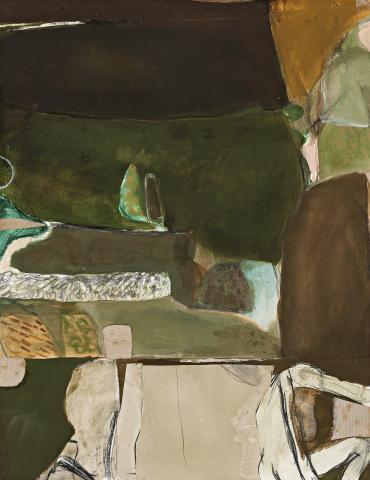GREEN LANDSCAPE, 1962
BRETT WHITELEY
mixed media with collage on paper
66.0 x 50.0 cm
Rudy Komon Gallery, Sydney
Roger Welsh, Sydney, acquired from the above in 1963
Artarmon Galleries, Sydney
Private collection, Sydney
Joseph Brown Gallery, Melbourne, acquired from the above in 1971
Private collection,
Sotheby’s, Melbourne, 22 April 1996, lot 192, (as ‘Figure in Landscape’)
Private collection, Sydney
Brett Whiteley, Rudy Komon Gallery, Sydney, 10 April – 10 May 1963, cat. 15 (as ‘Green Landscape’)
Autumn Exhibition, Joseph Brown Gallery, Melbourne, 3 – 21 March 1971, cat. 38 (as ‘Composition with Nude’)
Sutherland, K., Brett Whiteley: A Sensual Line, 1957–67, Macmillan Art Publishing, Melbourne, 2010, cat. HH3, p. 257 (illus.)
Hopkirk, F., BRETT: A Portrait of Brett Whiteley by His Sister, Pan McMillan, Sydney, 1996, p. 150
By the time Brett Whiteley arrived in London in 1961, several leading Australian artists had held successful exhibitions there. Arthur Boyd, Russell Drysdale and Sidney Nolan were among them. They and other well known artists had featured in the 1961 landmark exhibition Recent Australian Art at the Whitechapel Gallery. Then Art Gallery of New South Wales director Hal Missingham, who was in London at the time, suggested to Whitechapel director Bryan Robertson that he consider an unknown Brett Whiteley for the exhibition. Robertson agreed and three works painted earlier that year in Italy were included. Whiteley became the star of the show, and this successful international debut opened the door just enough to allow him to then kick it in.
Almost overnight he became the golden boy of Australian art, with a major sale to London’s Tate Gallery, the promise of an exhibition at the prestigious Marlborough Gallery and a string of eager buyers ensuring that the good times continued. It was indeed a happy time for Brett and Wendy Whiteley, flush with funds from Brett’s successful exhibition at the Matthiesen Gallery. On 27 March 1962, with fellow artist Michael Johnston in attendance as the best man, they married and headed to Southern France on their honeymoon. There they moved into a rustic villa surrounded by a walled garden; there was also a barn that served as Whiteley’s studio. They settled into the rhythm of the summer and a fruitful several months followed. Brett later described this idyllic time saying ‘we just watched the sun ripen the grapes and painted.’1
The works Whiteley produced during this French sojourn included several of his most important early paintings. Summer at Sigean, 1962-63, now in the collection of the National Gallery of Australia, Canberra, was amongst them, although it was completed in London. The larger works were developed in tandem with works on paper, and each informed the development of the major paintings.
Green Landscape, 1962, was among these informative works gently depicting the surrounding French landscape through the prism of Whiteley’s early influences. The British painter William Scott’s gentle geometry is recognisable as shapes fold and nudge their way around the surface. The forms appear to jostle for prominence as they seek to contain the underlying theme of the work. These are ‘landscapes’, but as Kathie Sutherland puts it, ‘each work can be seen as an expression of Whiteley’s state of mind, of his absorption into his relationship with Wendy and his rapturous response to this time and place’.2 Green Landscape evolved as the artist wrestled with his conflicted sense of subject; on the one hand he is bound by the pursuit of abstraction and on the other the increasing pull of figuration and his intuitive feeling for sensual expression in art.
Importantly, the work created during this time formed the springboard for the work which was to follow. On their return to London in late 1962 Whiteley emerged from his wrestle with abstraction and figuration, and embarked on a creative spree that was to last several years. Exhibitions and recognition followed. His celebrated Bathroom, Christie and Zoo series are arguably some of his most accomplished paintings, and each contain a thread that reaches back to 1962 and the languid summer spent in Sigean.
1. Sutherland, K., Brett Whiteley: A Sensual Line 1957-67, Macmillan Art Publishing, Melbourne, 2014, p. 74
2. Ibid.
HENRY MULHOLLAND
